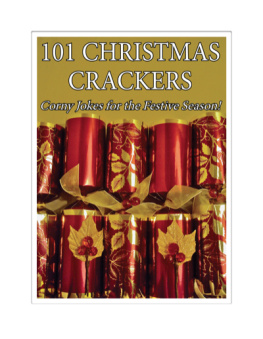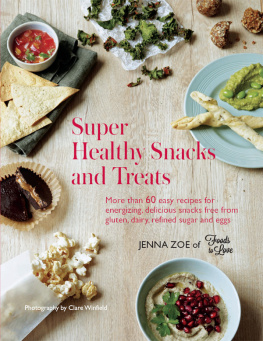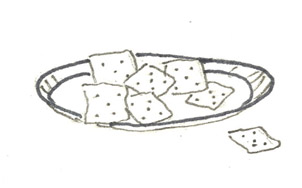A B R I E F H I S T O R Y O F T H E C R A C K E R
W HO REALLY INVENTED THE CRACKER? In 1792 Theodore Pearson of Newburyport, Massachusetts, owned Pearson and Sons Bakery. He combined flour and water into a hardtack he called Pearsons Pilot Bread. Because of its long shelf life, the pilot cracker became a great favorite with sailors, who relied on it for sustenance on long sea voyages. This type of cracker was manufactured in the United States until 2008.
The prototype of todays modern cracker came about by accident. According to stories, in 1801 Josiah Bent of Massachusetts, owner of the Josiah Bent Bakery, left a batch of biscuits in the oven just a little too long, and they began to crackle. Bent played with the recipe and came up with a snack food that sold like hotcakes. In 1889 Bent sold his bakery to William Moore. Moore acquired six other bakeries and started the New York Biscuit Company. In 1890 Adolphus Green obtained forty different bakeries and started the American Biscuit & Manufacturing Company. These two large bakery firms converged in 1898, becoming the National Biscuit Company, whose name later was shortened to Nabisco. Now part of Kraft Foods, Inc., Nabisco is still a leading manufacturer of crackers in the United States.
A W O R D A B O U T S H A P E S
A LL THE CRACKERS IN THIS BOOK were made using a two-inch round biscuit cutter as a shape. This was to make it easier to compute the number of crackers each recipe makes. However, please feel free to experiment with other shapes, like squares, triangles, clovers, and so on. Break out the cookie cutters and make caraway-rye men instead of gingerbread men for Christmas, cheddar cheese stars, lemony-dill ducks, tomato-basil turkeys, or whatever shape cutters you happen to have. You are only limited by your imagination! Just remember that the quantity of crackers each recipe produces will change, depending on the shape you choose. If the cutter is similar in size to a two-inch circle, then the number of crackers will be about the same. Have fun experimenting!
ACKNOWLEDGMENTS
This book would not have been possible without my husband, Jeffrey Thomas, who acted as my chief taste tester for all these recipes. He willingly ate batch after trial batch of crackers and offered me fair criticism on each new version. He suggested refinements to each recipe so that every cracker would be a balance of taste and texture. Imagine my dismay when Jeffrey came down with a head cold and was unable to taste anything for over two weeks, right when I was in the middle of experimenting with the most recipes!
Id also like to thank my two younger sons, Johann and Finn, who also acted as guinea pigs in this project and ate many a cracker. They even coerced their friends into trying some of the more unusual combinations, which was a big help to me. And my oldest son, Yule, provided encouragement over the phone from his island home of Hawaii.
My sincere gratitude to my mother, Joan Cart, who did all the illus-trations. On somewhat short notice, she was able to provide an artistic layer to this book, a concept I had not even considered when I first started experimenting in the kitchen. And thanks to my dad, who always believes I am able to achieve whatever I set my mind to doing.
Big thanks are also due to my next-door neighbors, Angela DeRosa, Lucy Cayard, and Steve Cayard. Angela is an excellent cook in her own right, so her evaluation of flavors and suggestions for ways to tweak these recipes was a great help. Lucys enthusiasm for the project helped me through many a dreary day when I thought I might be on the wrong track. And Steve provided a much-needed male perspective that was not over-shadowed by being my spouse.
Amber Reed, a talented cook and cheesemaker, gave me the valuable insights on cheeses. I am grateful for Ambers help in this department.
Thanks to Martha Young and Richard Garrett for working with me on short notice on a muddy, snowy March day. It was good fun!
Other friends unknowingly played a part in this project by eating new cracker recipes at many potlucks and dinner parties. Usually known for my cookies, I brought trays of crackers to these gatherings instead, much to the dismay of some people hoping for my mint chocolate chip cookies. But I am thankful for the feedback I received from these folks as well.
And many, many thanks to Peter Burford, my editor at Burford Books, as well as all the other folks at Burford Books. Without Peters feedback and encouragement, this project would probably never have been finished. Peter, many thanks for helping me fulfill one of my life dreams of writing my very own cookbook.
And thanks to you, dear readermay you enjoy these recipes and have fun experimenting with flavors and ideas of your very own.
The Basic Recipe
The foundation for all your cracker making ideas.
YIELD: APPROXIMATELY 2630 2-INCH CIRCLES
BAKE: 350 FOR 1518 MINUTES OR UNTIL GOLDEN BROWN ON BOTTOM
1 C. unbleached all-purpose flour
tsp. salt
2 T. oil
4 T. liquid
Flavorings and spices to blend into mixture or sprinkle on top
Extra all-purpose flour for rolling
- Blend together all-purpose flour and salt.
- Add oil and liquid.
- Blend wet ingredients into dry ingredients until a soft dough is formed.
- Sprinkle rolling surface with all-purpose flour and roll dough to -inch thickness.
- Cut dough into 2-inch circles.
- Place dough on ungreased cookie sheets.
- Re-form dough scraps into a ball, re-roll, and cut into circles until all dough is used.
- Prick circles two or three times with the tines of a fork.
- Bake until golden brown on the bottom.
HELPFUL TIPS
T HE MAIN THING TO REMEMBER when making crackers is to keep the ratios the same. It doesnt really matter what kind of flour, oil, or liquid you use, as long as the proportions of one to the other are about the same so that the dough that forms is soft and pliable to roll and bakes into a crisp cracker. Measuring for recipes is an approximation; if you feel the texture is too dry because you added a little bit more flour, add a few drops more liquid to soften that dry flour. If the mixture is sticky and wont form into a smooth dough, then add a sprinkle or two of flour to absorb the moisture.
If you use a little more oil, the crackers will be slightly greasier when baked. If you use more water, theyll be crunchier. Increasing the liquids will mean a slight increase in the amount of flour needed to produce a smooth dough that holds together for rolling. If you use milk instead of water, the crackers will be slightly softer and richer. I have developed all the cracker recipes in this book without milk because Im lactose-intolerant, but you can substitute milk for the water in almost all of these recipes.
Once youve blended the dry ingredients together, you can add the wet ingredients directly to the same bowl, one by one. Just be sure to blend the resulting dough thoroughly so all the ingredients are evenly distributed.
If you want to use a low-gluten flour such as buckwheat or millet, make sure to blend in some all-purpose flour so the dough that forms is pliable enough to roll.
Mixing the ingredients by hand allows you to knead the dough for a few seconds, ensuring a smooth texture for rolling.
Feel free to sprinkle seeds and chopped nuts on top of these crackers as well as adding them into the dough. Try poppy seeds on the Whole Wheat Crackers (page XX) or sesame seeds on the Green Tea and Brown Rice Crackers (page XX). Lightly brushing each cracker with water will help the seeds to stick during the baking process.








